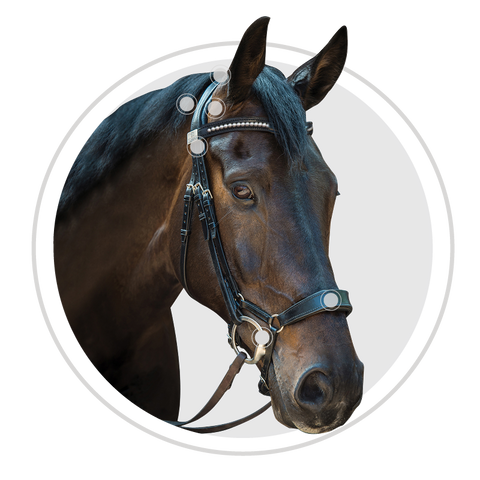Bridle Testing & Design
Researchers tested under all areas of a large number of bridles on a variety of horses using Pliance pressure mapping technology and gait analysis to identify the exact location of high-pressure zones and demonstrate the performance improvements when bridle pressure is removed.
The scientific research proved:
1.
There are six key high-pressure zones
- back edge of headpiece
- front of headpiece
- under the browband
- under the front of the noseband
- under the back of the noseband
- over the crown of the head

2.
Bridle pressure is not constant, it is influenced by factors such as ground reaction force when landing over a fence or taking a stride, or by a natural reflex such as swallowing.
3.
Stability enhances comfort. The horse’s performance deteriorates the more movement there is around the crown of the head. So, the answer to bridle pressure is not a loose or baggy bridle. The answer is a bridle that remains consistently stable against the head and moves with the horse, not against him.
4.
Articulation points on the bridle design allow the components to move independently and in harmony with the horse’s movement, instead of being rigid, so pressure is effectively reduced.
5.
Most bridles exert hardly any poll pressure. Pressure is higher each side of the poll, behind the ears and under the browband.
6.
Gait analysis proves a significant decrease in knee flexion when there is asymmetry around the horse’s head – for example if buckles are on one side only or competition numbers are one side in the line of vision.
7.
Pressure exerted on either side of the nasal bone by a ’normal’ cavesson noseband is four times higher than that we measured under a saddle.
8.
A cavesson noseband fitted high up against the cheekbones puts pressure on arteries running directly under the end of cheekbone and causes reduced joint flexion compared to a correctly fitting noseband.
9.
The flash noseband had the highest pressures and the most detrimental effect on a horse’s movement. A flash strap that drags down the lower edge of the cavesson is the most antagonistic design we tested.
10.
Drop and grackle nosebands perform better in terms of pressure reduction and freedom of movement compared to any other conventional noseband we tested.
11.
A correctly fitted crank noseband with articulation rings at the side exerts less pressure than a normal cavesson (tested at the same tightness). NOTE: pressure under any bridle can be intensified by over-tightening or poor fitting.

Comfort factors
a. Central lozenge to maintain stability
b. Narrowed to avoid interference with back edge of the skull
c. Splits are lowered for stability and are symmetrical both sides
d. Noseband attaches both sides for symmetry
e. Prolite pads lift the bridle clear of pressure points below the browband
f. Noseband and headpiece are lined with Prolite for comfort
g. Prolite pad lifts the noseband clear of the nasal bone, relieving pressure on the sensitive areas either side
h. Noseband rings for articulation
A note on the TMJ
The Temporomandibular joint (TMJ) is involved with swallowing and jaw movement, but it is also an important location for nerves that control proprioception and balance.
High pressure here can affect the entire horse’s movement because so many muscles associated with movement in the horse’s body link to this area through chains of muscle and fascia.
As the horse swallows the sides of his face push up and out against the ‘fixed’ joint of the headpiece and browband. If the bridle is tight here it will make this natural act uncomfortable.
The pads on the patented Fairfax headpiece lift the bridle clear of of these pressure points beneath the browband, removing pressure. This has been proven to improve forelimb extension and knee & hock flexion.

